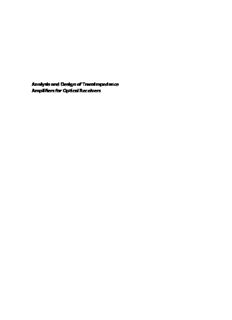
Analysis and design of transimpedance amplifiers for optical receivers PDF
Preview Analysis and design of transimpedance amplifiers for optical receivers
(cid:2) AnalysisandDesignofTransimpedance AmplifiersforOpticalReceivers (cid:2) (cid:2) (cid:2) (cid:2) Analysis and Design of Transimpedance Amplifiers for Optical Receivers EduardSäckinger (cid:2) (cid:2) (cid:2) (cid:2) Thiseditionfirstpublished2018 ©2018JohnWiley&Sons,Inc. Allrightsreserved.Nopartofthispublicationmaybereproduced,storedinaretrievalsystem,or transmitted,inanyformorbyanymeans,electronic,mechanical,photocopying,recordingor otherwise,exceptaspermittedbylaw.Adviceonhowtoobtainpermissiontoreusematerialfrom thistitleisavailableathttp://www.wiley.com/go/permissions. TherightofEduardSäckingertobeidentifiedastheauthorofthisworkhasbeenassertedin accordancewithlaw. RegisteredOffices JohnWiley&Sons,Inc.,111RiverStreet,Hoboken,NJ07030,USA EditorialOffice 111RiverStreet,Hoboken,NJ07030,USA Fordetailsofourglobaleditorialoffices,customerservices,andmoreinformationaboutWiley productsvisitusatwww.wiley.com. Wileyalsopublishesitsbooksinavarietyofelectronicformatsandbyprint-on-demand.Some contentthatappearsinstandardprintversionsofthisbookmaynotbeavailableinotherformats. LimitofLiability/DisclaimerofWarranty Thepublisherandtheauthorsmakenorepresentationsorwarrantieswithrespecttotheaccuracy orcompletenessofthecontentsofthisworkandspecificallydisclaimallwarranties;including (cid:2) (cid:2) withoutlimitationanyimpliedwarrantiesoffitnessforaparticularpurpose.Thisworkissold withtheunderstandingthatthepublisherisnotengagedinrenderingprofessionalservices.The adviceandstrategiescontainedhereinmaynotbesuitableforeverysituation.Inviewofon-going research,equipmentmodifications,changesingovernmentalregulations,andtheconstantflow ofinformationrelatingtotheuseofexperimentalreagents,equipment,anddevices,thereaderis urgedtoreviewandevaluatetheinformationprovidedinthepackageinsertorinstructionsfor eachchemical,pieceofequipment,reagent,ordevicefor,amongotherthings,anychangesinthe instructionsorindicationofusageandforaddedwarningsandprecautions.Thefactthatan organizationorwebsiteisreferredtointhisworkasacitationand/orpotentialsourceoffurther informationdoesnotmeanthattheauthororthepublisherendorsestheinformationthe organizationorwebsitemayprovideorrecommendationsitmaymake.Further,readersshould beawarethatwebsiteslistedinthisworkmayhavechangedordisappearedbetweenwhenthis workswaswrittenandwhenitisread.Nowarrantymaybecreatedorextendedbyany promotionalstatementsforthiswork.Neitherthepublishernortheauthorshallbeliableforany damagesarisingherefrom. LibraryofCongressCataloging-in-PublicationDataAppliedFor: ISBN:9781119263753 CoverdesignbyWiley Coverimage:©shuoshu/Gettyimages Setin10/12ptWarnockProbySPiGlobal,Chennai,India PrintedintheUnitedStatesofAmerica 10 9 8 7 6 5 4 3 2 1 (cid:2) (cid:2) ToElizabethandMarianne (cid:2) (cid:2) (cid:2) (cid:2) vii Contents Preface xi 1 Introduction 1 1.1 OpticalTransceivers 1 1.2 ModulationFormats 5 1.3 TransmissionModes 12 References 19 (cid:2) 2 OpticalFibers 23 (cid:2) 2.1 LossandBandwidth 23 2.2 Dispersion 26 2.3 Nonlinearities 32 2.4 PulseSpreadingduetoChromaticDispersion 35 2.5 Summary 38 Problems 39 References 40 3 Photodetectors 43 3.1 p–i–nPhotodetector 43 3.2 AvalanchePhotodetector 58 3.3 p–i–nDetectorwithOpticalPreamplifier 65 3.4 IntegratedPhotodetectors 77 3.5 DetectorsforPhase-ModulatedOpticalSignals 86 3.6 Summary 94 Problems 96 References 97 4 ReceiverFundamentals 107 4.1 ReceiverModel 107 4.2 NoiseandBit-ErrorRate 109 4.3 Signal-to-NoiseRatio 117 (cid:2) (cid:2) viii Contents 4.4 Sensitivity 120 4.5 NoiseBandwidthsandPersonickIntegrals 135 4.6 OpticalSignal-to-NoiseRatio 139 4.7 PowerPenalty 148 4.8 IntersymbolInterferenceandBandwidth 153 4.9 FrequencyResponse 165 4.10 Summary 170 Problems 172 References 174 5 TransimpedanceAmplifierSpecifications 181 5.1 Transimpedance 181 5.2 InputOverloadCurrent 186 5.3 MaximumInputCurrentforLinearOperation 187 5.4 Bandwidth 188 5.5 PhaseLinearityandGroup-DelayVariation 189 5.6 TimingJitter 190 5.7 Input-ReferredNoiseCurrent 191 5.8 Crosstalk 197 5.9 ProductExamples 199 5.10 Summary 201 (cid:2) (cid:2) Problems 202 References 202 6 BasicTransimpedanceAmplifierDesign 207 6.1 Low-andHigh-ImpedanceFront-Ends 207 6.2 Shunt-FeedbackTIA 210 6.3 NoiseAnalysis 230 6.4 NoiseOptimization 242 6.5 NoiseMatching 254 6.6 Summary 267 Problems 269 References 272 7 AdvancedTransimpedanceAmplifierDesignI 279 7.1 TIAwithPostAmplifier 279 7.2 TIAwithDifferentialInputsandOutputs 284 7.3 TIAwithDCInputCurrentControl 289 7.4 TIAwithAdaptiveTransimpedance 292 7.5 Common-BaseandCommon-GateTIAs 301 7.6 Regulated-CascodeTIA 312 7.7 TIAwithInductiveBroadbanding 320 7.8 Distributed-AmplifierTIA 325 (cid:2) (cid:2) Contents ix 7.9 Summary 331 Problems 333 References 334 8 AdvancedTransimpedanceAmplifierDesignII 343 8.1 TIAwithNonresistiveFeedback 343 8.2 Current-ModeTIA 349 8.3 TIAwithBootstrappedPhotodetector 351 8.4 Burst-ModeTIA 352 8.5 AnalogReceiverTIA 360 8.6 Summary 364 Problems 365 References 365 9 TransimpedanceAmplifierCircuitExamples 373 9.1 BJT,HBT,andBiCMOSCircuits 373 9.2 CMOSCircuits 380 9.3 MESFETandHFETCircuits 387 9.4 Summary 389 References 392 (cid:2) (cid:2) A CommunicationSignals 397 A.1 Non-Return-to-ZeroSignal 397 A.2 Return-to-ZeroSignal 401 A.3 PulseAmplitude-ModulatedSignal 403 A.4 AnalogTelevisionSignal 406 A.5 DigitalTelevisionSignal 408 References 411 B EyeDiagrams 413 References 420 C TimingJitter 421 C.1 DataJitter 421 C.2 ClockJitter 431 C.3 Jitter,PhaseNoise,andBit-ErrorRate 435 Problems 438 References 438 D Nonlinearity 441 D.1 GainCompression 442 D.2 HarmonicDistortions 443 D.3 IntermodulationDistortions 444 (cid:2) (cid:2) x Contents D.4 CompositeDistortions 446 Problems 449 References 449 E AdaptiveEqualizers 451 E.1 FeedforwardandDecision-FeedbackEqualizers 452 E.2 AdaptationAlgorithms 456 E.3 HardwareImplementations 460 Problems 463 References 463 F Decision-PointControl 469 Problems 473 References 473 G ForwardErrorCorrection 475 Problems 481 References 481 H Second-OrderLow-PassTransferFunctions 483 (cid:2) References 495 (cid:2) I AnswerstotheProblems 497 References 533 J Notation 537 K Symbols 539 L Acronyms 549 Index 557 (cid:2) (cid:2) xi Preface Transimpedanceamplifiers(TIA)areusedatthefrontendofopticalreceivers. Theycanalsobefoundatthefrontendofreadcircuitsforopticalstoragesys- temsandlaserRADARsystemsfordistancemeasurement.ButTIAsarenot limited only to optical applications; particle/radiation detector chips, vision sensorchips,biologicalsensorchips,motionsensorsinmicroelectromechan- icalsystems,andwidebandradioreceiversalsomakeuseofTIAs. This broad range of applications is not surprising. The TIA is essentially a sensitive and fast current measurement device: A weak current signal, typi- cally originating from a sensor such as a photodetector, a particle/radiation (cid:2) (cid:2) detector,abiologicalsensorelectrode,aMEMSelectrostatictransducer,ora radio receiver antenna, is amplified and converted into a voltage signal. The term transimpedance derives from the older term transfer impedance, which indicates that an input current at one port is producing an output voltage at anotherport. Thetermtransimpedanceamplifiermayevoketheimageofavoltageampli- fierwithashunt-feedbackresistor.However,thisisjustoneparticularimple- mentation.SeveralothertopologiesexistandnovelTIAcircuitsarestillbeing invented today. Each circuit presents a different trade-off between sensitiv- ity(noise),speed(bandwidth),power,area,andotherperformancemeasures. Witheachapplicationhavingitsownsetofrequirements,differentapplications benefitfromdifferentcircuitdesigns. Book Outline. Chapters 1–4 provide background information on optical communication.Thispartof thebook establishesusefulcontext for thelater chaptersonTIAdesign.Readerswhoarenotinterestedinopticalapplications mayskipovermuchofthismaterial. Chapter 1 describes the components that make up conventional and digi- talcoherentopticalreceiversandtransmitters.Commonmodulationformats (NRZ,RZ,4-PAM,QPSK,SCM,etc.),modulationcodes,transmissionmodes (continuousmodeandburstmode),andstandardsareintroduced. (cid:2) (cid:2) xii Preface Chapter 2 is about the communication channel presented by the optical fiber. Its loss, bandwidth, various forms of dispersion, and nonlinearities are described. The compensation of loss and dispersion and the mitigation of nonlineareffectsarediscussedbriefly. Chapter3coverstherelevantphotodetectors.Theresponsivity,bandwidth, andnoisepropertiesofthep–i–nphotodetector,theavalanchephotodetector (APD), and the optically preamplified p–i–n detector are examined. Then, integrated detectors including detectors for silicon photonics are covered. Finally,detectorsforphase-modulatedsignals(QPSK,DQPSK,etc.)including thecoherentdetectorwithphaseandpolarizationdiversityarediscussed. Chapter4dealswiththereceiveratthesystemlevel.Ananalysisofhownoise inthereceivercausesbiterrorsleadstothedefinitionofthereceiversensitivity in unamplified transmission systems and the required optical signal-to-noise ratio(requiredOSNR)inamplifiedtransmissionsystems.Powerpenaltiesdue toreceiverimpairments,suchasintersymbolinterference(ISI),arediscussed. Ananalysisofthetrade-offbetweennoiseandISIleadstorecommendations forthereceiver’sbandwidthandfrequencyresponse. TheremainderofthebookfocusesontheanalysisanddesignofTIAs. Chapter 5 introduces the main specifications, such as the transimpedance, bandwidth, phase linearity, group-delay variation, jitter, input-referred noise (cid:2) current,maximuminputcurrent,andcrosstalk.Themeasurementofsomekey (cid:2) parametersisdiscussed.Examplevaluesfromrecentproductdatasheetsare giventoillustratethespecifications. Chapter 6 covers the popular shunt-feedback TIA in detail. The tran- simpedance, input impedance, and output impedance are calculated. The stability and the transimpedance limit of single and multistage implementa- tions are analyzed. The noise performance of TIAs with FET and BJT front endsarederived.Ogawa’snoisefactoranditsrelationshiptoinducedgatenoise isexplained.Then,thenoiseoptimizationofTIAswithFETandBJTfrontends bymeansofdevicesizingandbiasingisdiscussed.Theimpactofconstraints, suchasaconstantgain-bandwidthproduct,onthenoiseoptimumisexamined. Finally,noisematchingnetworksandtheirpropertiesareinvestigated. Chapter 7 extends the basic shunt-feedback TIA with practical features such as a postamplifier, differential inputs and outputs, DC input current control, and adaptive transimpedance. Then, the chapter turns to alternative TIA topologies such as the common-base TIA, common-gate TIA, the regulated-cascodeTIA,andthedistributed-amplifierTIA. Chapter 8 examines additional TIA circuit techniques such as capacitive feedback,opticalfeedback,activefeedback,currentmode,andphotodetector bootstrapping. Then, the chapter turns to TIAs for specialized applica- tions, namely burst-mode TIAs (e.g., for passive optical networks) and analog-receiver TIAs (e.g., for hybrid fiber-coax networks or microwave photoniclinks). (cid:2)
Description: